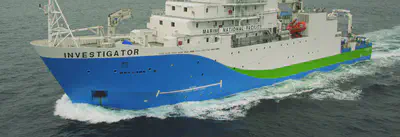Expedition to the Coral Sea
This blog chronicles the voyage on the RV Investigator to collect rock samples from the sea floor.
Aim of the game
- Determine the spatial and temporal extent of mantle plume activity in the Coral Sea
- Understand the effect of neighbouring plate boundaries on the formation and entrainment of the reported anomalous mantle underlying the region

We will undertake a multi-disciplinary study combining geophysical characterisation and targeted geological sampling of plume-related volcanics in the Coral Sea, via a research voyage led by Whittaker (UTas) and Williams (USyd).
During this project, Fitton and Cohen (UEdin) will conduct a detailed petrographic analysis of the samples to determine rock type, eruptive environment and source. Major and trace element geochemistry and geochronology (Ar-Ar technique) will be started as part of this project, with the full suite of results expected beyond the timeframe of this project. Magnetic and gravity interpretation over the volcanic edifices will led by Kalnins (Edinburgh) and bathymetric characterization by Beaman (JCU). Kalnins will be responsible for coordinating the analytical component, fully-funded via a NERC grant.
But why?
One of the world’s most extensive intraplate volcanic regions is located in Eastern Australia, including the world’s longest continental hotspot trail and two parallel trails offshore (Tasmantid and Lord Howe Seamount chains). Hotspot trails are thought to arise from mantle plumes, whose episodic eruptions have caused environmental crises affecting the world’s atmosphere (release of gas and aerosols), biosphere (mass extinctions) and hydrosphere (altering ocean circulation and chemistry). Identifying mantle plume eruptions in the geological record provides us with a window into the deep Earth.
We will use the Coral Sea as a natural laboratory to test competing hypotheses for how deep mantle plumes have influenced the evolution of the Australian plate. In addition, using data-science approaches, we will assess whether the mantle that these volcanoes is sampling is anomalous and what influence neighbouring plate boundaries have on mantle chemistry.
Who’s in charge?
We were successfully awarded ship-time on Australia’s Marine National Facility (MNF), the RV Investigator.
- Dr. Maria Seton from The University of Sydney (lead applicant)
- A/Prof. Jo Whittaker, University of Tasmania (chief scientist)
- Prof. Simon Williams (deputy chief scientist)
Impacts of this research
This project seeks to determine the extent of plume activity in the Coral Sea and explore the factors controlling the geochemical make-up of the mantle, will facilitate breakthroughs in answering some of the most challenging questions in Earth Sciences such as how the deep Earth communicates with the surface, what controls the heterogeneity in mantle chemistry and the validity of the mantle plume hypothesis itself.
Our results will have implications for natural hazards, deep-sea resources, and habitat mapping. Mapping submarine seamount morphologies coupled with age-dating of volcanoes provides constraints on the degradation of volcanic edifices through time and their tsunamigenic potential in modern analogue settings. Our petrological and geochemical analysis of volcanism will provide an exploration framework for unexplored but potentially lucrative seafloor mineral resources, which are an important source of critical metals necessary for our renewable energy future. The geomorphological study of seamounts, naturally important habitats for open-ocean ecosystems, may help identify areas of significant conservation value.


